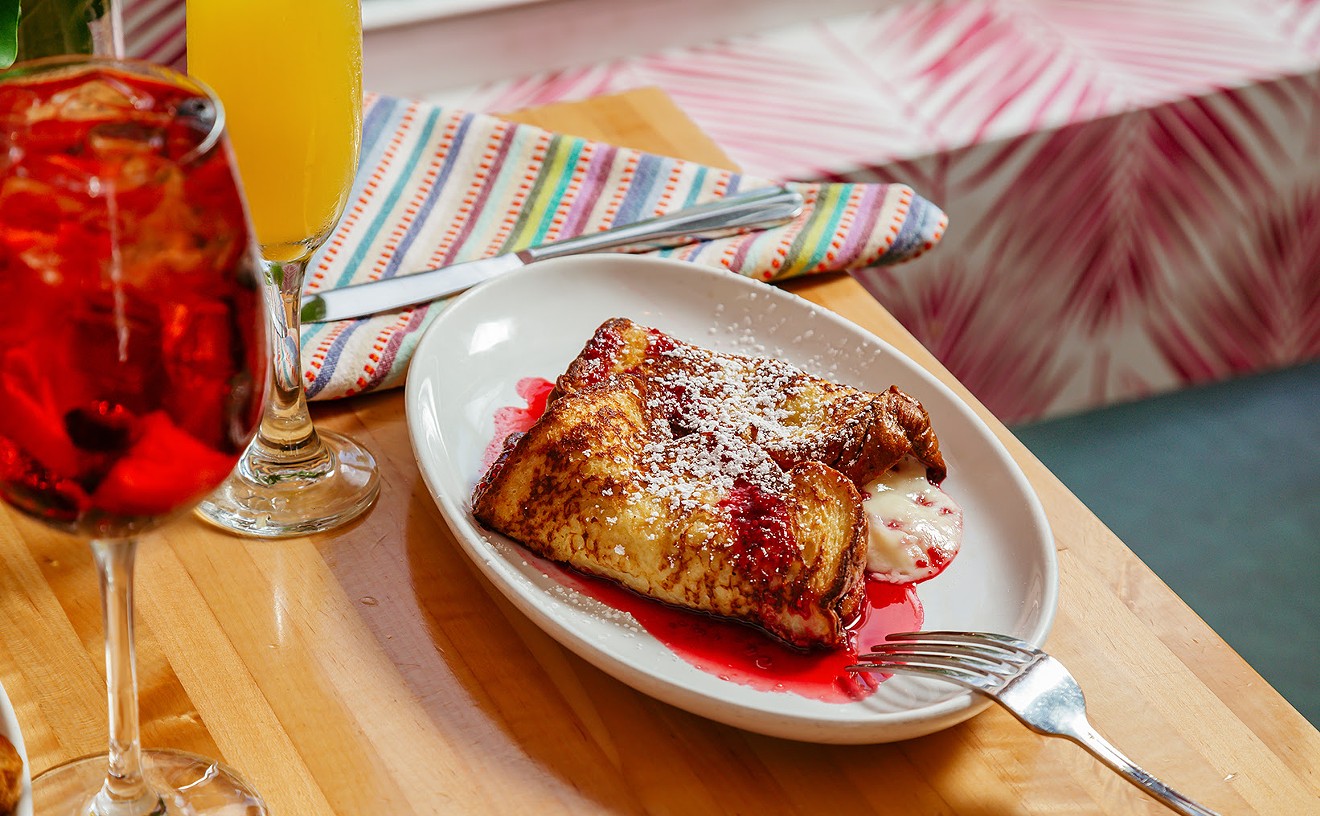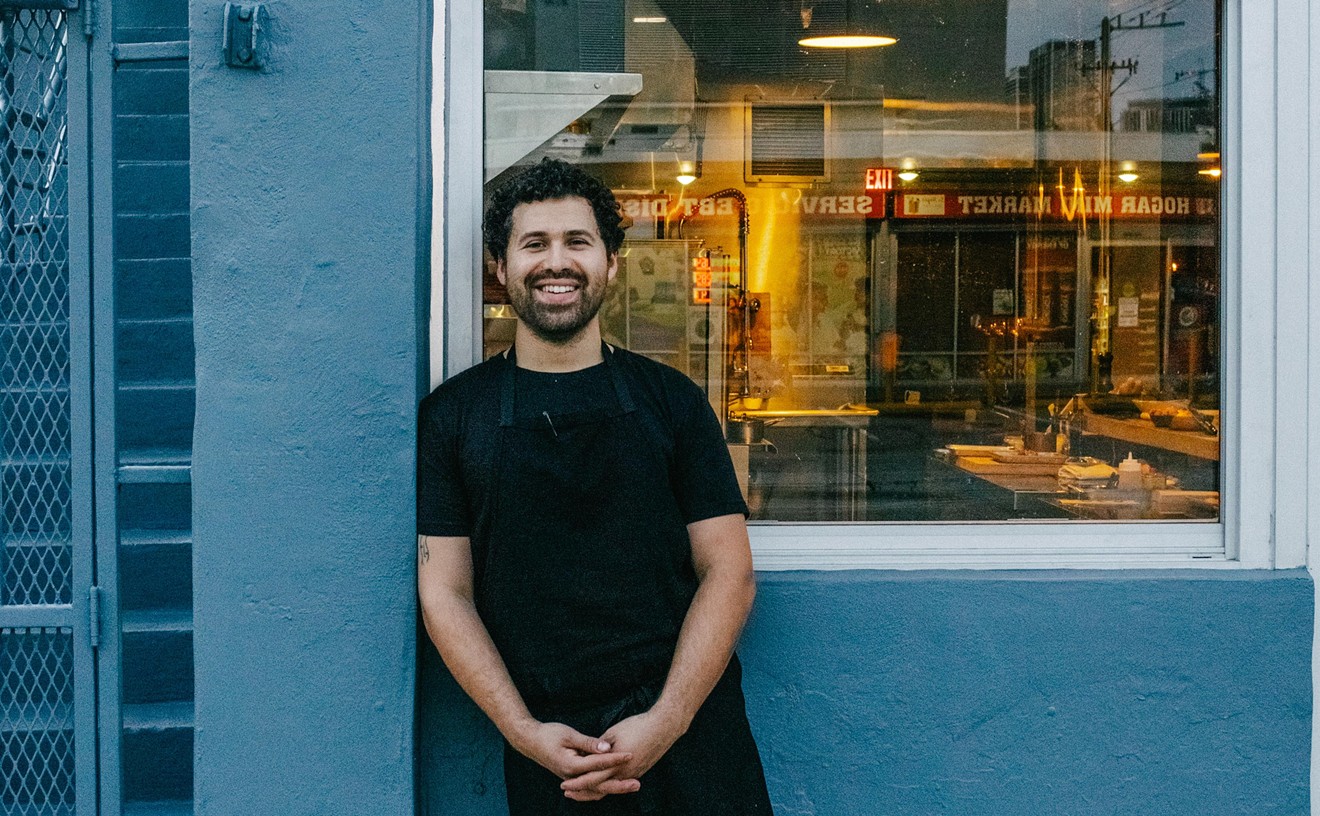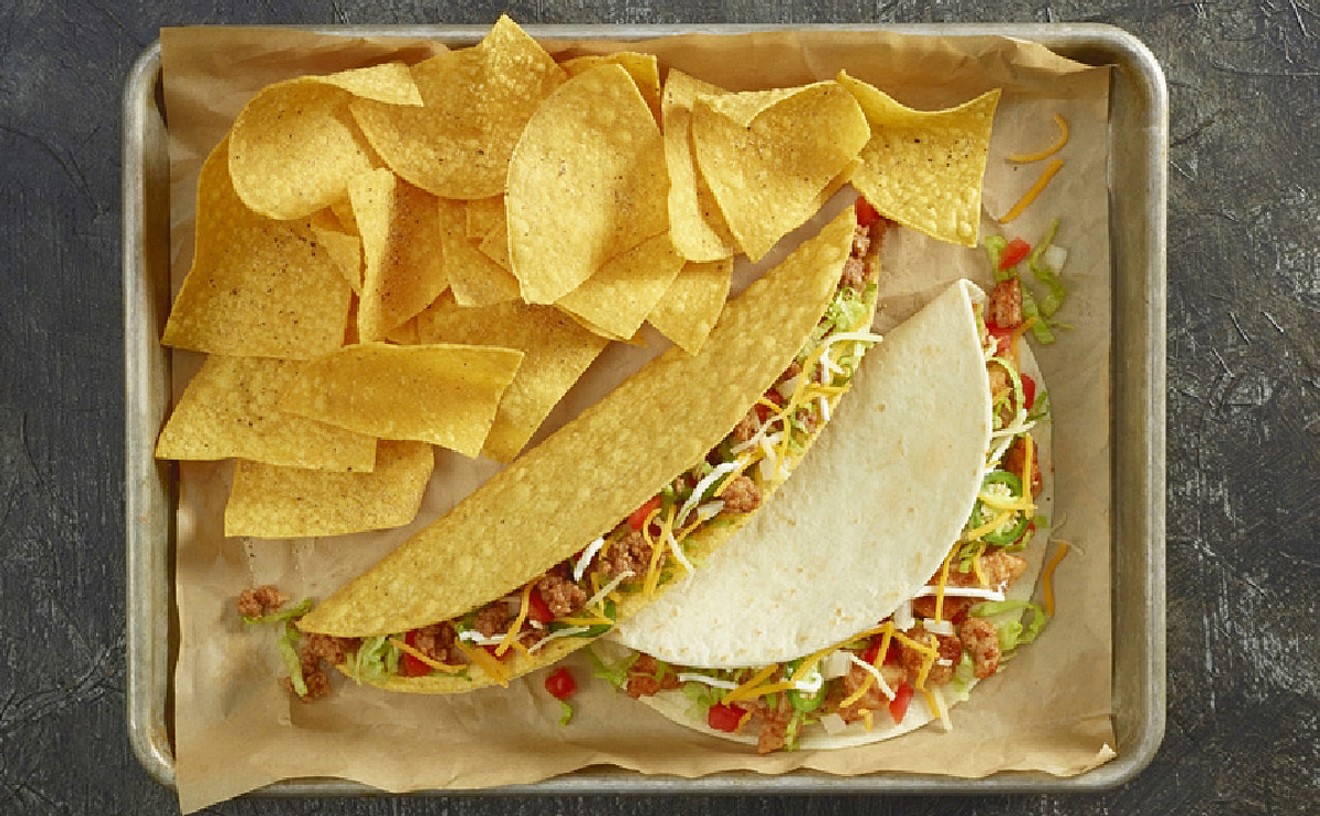Actually, I don't mind spending a couple of hours on a meal. Here in the United States, though, a nation where people pace the floor in front of microwave ovens, Nguyen's insistence on cooking food to order, by herself, coupled with slow and at times chaotic service, is bound to exasperate more than a few diners. Like the couple seated next to us during a recent visit. They waited fifteen minutes before a waiter came over to take their order, at which point they informed him they hadn't yet seen a menu. Another twosome turned to them and volunteered in a not-so-confidential tone that they had arrived an hour and a half earlier and were still waiting for their entrees. Everyone smiled and shook their heads in disbelief. "The food is good, though," one reluctantly admitted.
The food is good -- a simple, elemental take on traditional Vietnamese cooking. While successive foreign occupations have left Vietnam with a scarred landscape and a battered national pride, the invaders also bequeathed the country an enviable catalogue of culinary influences. Ten centuries of Chinese rule introduced stir-frying, deep-frying in a wok, soy sauce, bean curd, noodles, and chopsticks (the Vietnamese are the only people in Southeast Asia to use them). Mongolian forays during the Thirteenth Century brought meat dishes. Sixteenth-century European explorers planted seeds for the artichokes, cauliflower, corn, tomatoes, potatoes, and peanuts that farmers of central Vietnam still grow today. A century of French domination left behind the techniques of breadmaking and a general refinement of existing baking and cooking. And finally, because of the United States's nasty involvement, the Vietnamese get to wash down all of this interesting and distinctive cuisine with a Pepsi.
The southern part of Vietnam, from where Nguyen hails, takes its strongest culinary cues from Laos, Cambodia, and Thailand, all of which at one time or another have fallen under India's influence and have thus been introduced to the subcontinent's spices and curries. Nguyen's cooking, like that of her homeland, tends to assimilate foreign notions of food rather than merely imitate them. Both the Vietnamese and Thais, for instance, use ingredients such as fish sauce, shrimp paste, lemon grass, mint, basil, chili peppers, and curry, but the resulting dishes are quite different. Vietnamese curries in particular are less intense than those of other Southeast Asian nations, as is evident in Tung Vietnamese Cuisine's tame entree of curried shrimp and crab. The thin, mustard-color curry broth, though mellow, has a smooth, aromatic flavor that's fine; it's the rubberiness of the five slightly overcooked shrimp and the too-scarce smattering of lump crabmeat that mar this preparation.
Another scarcity is apparent here too. The Vietnamese consume an abundance of green vegetables, a practice learned from the Thais that has led to the development of a vegetarian cuisine incredible in its variety, complexity, and taste. Why then, in the name of Linda McCartney, is there not a single vegetarian entree on Tung's menu, nor any vegetables served as accompaniments?
I should talk. I grew up eating lean tongue sandwiches at kosher delis in New York City. But I've since licked that habit, and not even the appeal of being able to write about Tung tongue with ginger sauce could entice me into ordering it here. We opted for just about every other appetizer on the menu, starting with banh cuon, a.k.a. pork rolling cakes, a.k.a. pork dumplings -- two puffy bundles wrapped in rice noodles and floating in an ethereally light broth scattered with scallions, mint, and caramelized shallots.
Next up: spring rolls. The Vietnamese have a reputation for making the best ones in Asia. They roll their rice noodles so thin as to make them semitransparent, dry them outdoors on bamboo mats, and fill them with ground pork, water chestnuts, mushrooms, and slippery, gelatinous cellophane noodles. Just before they're fried, the rolls get brushed with sugar water, which makes for extra-crispy, golden-brown exteriors. Nguyen prepares her spring rolls in this manner and serves them in a traditional style -- with lettuce leaves, which the waiter encouraged us to wrap around the rolls in order to facilitate their handling. A dish of nuoc cham came on the side, a condiment used both as a dip and as a mild flavor-booster to be squirted into stir-fries and soups. (It blends so discreetly that you can barely detect its presence.) The main ingredient is nuoc mam, a pungent, salty sauce that is lighter than soy and is used in a similar fashion. (It's actually the liquid siphoned from long-fermenting fish, and is very high in Vitamin B and protein.) Add sugar, water, garlic, and lime juice, and we're back to nuoc cham, which is particularly well-suited to be a grease-cutting foil for the crackling fried skins of Tung's spring rolls.
Shrimp on sugar cane sure looks like shrimp, but in truth it's a paste made from dried salted shrimp, garlic, sugar, pork fat, and nuoc mam. After being formed around a five-inch length of sugar cane, this unique kabob appetizer is barbecued and infused with a fantastic sweet and garlicky flavor. At five dollars for one, it's the worst deal on a very affordable menu; order it anyway.
At one dollar, kim chee is the best deal. Even more so because just a little of this screamingly hot pickled-cabbage salad goes a very long way -- it's not for the faint of heat. Neither is an appetizer of spicy pork ribs, which came chopped into small pieces and covered in a piquant brown sauce that gets its spice and color from roasted chili peppers and its charm from nuoc mam, lemon juice, and thinly sliced scallions. A cooler starter is the squid salad, a generous tangle of tenderly poached tentacles and rings tossed -- with way too many sweet onions -- in a zesty dressing of lemon grass, ginger, and lime.
With their entrees diners are offered a choice between a crisp iceberg lettuce, cucumber, red onion, and tomato salad soused in sassy rice wine vinegar, or the "light" soup of the day (as opposed to the menu's "hearty" soup, available only a la carte). We opted for the beef and pineapple soup, a light but concentrated meaty broth containing nuoc mam, garlic, scallions, and a minimal but refreshing whisper of the sweet fruit.
Dinners are also accompanied by rice, the mainstay of the Vietnamese diet for thousands of years. More than 80 percent of the country's work force is engaged in growing this crop, and it comes in hundreds of varieties. The Vietnamese generally prefer long-grain white rice, but they also make extensive use of the starch in noodle form. Nguyen prepares her own rice noodles, and the numerous dishes that contain these are the most satisfying on the menu. Barbecued pork, for instance, served in a bowl with the soft, delicate noodles complemented by crunchy ground peanuts, carrots, and bean sprouts -- all immersed in an aromatic lemon grass, nuoc mam, and butter-based broth. The cut of pork butt used was too fatty for my tastes. Bo bun is better, with the same noodle-peanut-broth combo in play, but featuring lean and juicy slices of beef instead of the tougher pork.
Lemon grass, like rice, is another example of Very Old World cuisine. Europeans have been enjoying it for centuries -- they call it citronella -- and Southeast Asians use it for all sorts of things: as an herb, for medicinal purposes, and even as an insect repellent. Tung's chicken and lemon grass uses the cream-white base of the plant to provide a fragrant lemon scent and flavor to the robust chicken stock, into which are simmered chunky pieces of white and dark meat, ginger, and the omnipresent nuoc mam.
Chicken breast in puff pastry with watercress cream-cheese sauce is an old Hy Vong standout, and it stands out here, too, mainly because it's the only entree to incorporate the Western influences mentioned earlier. The rich, buttery pastry shell -- as well as the concept of cheese sauce -- comes from the French; the peppery watercress, which adds a needed pungency to the dish, can be traced to those sixteenth-century Europeans; and the choice of cream cheese, of course, is straight from Philadelphia. Other curious Uncle Sam brand names on hand: Keebler crackers, Lipton tea, and Chock Full O' Nuts coffee.
While we're on the subject, I'd like to lodge a protest against the American occupation of Tung's dessert menu (official chant: "Hell no, we won't Jell-O!"). The intrusion of conventional confectionery troops such as brownies and "Dockside" chocolate chocolate-chip cake and key lime cake doctored up with ice cream, whipped cream, and chocolate sauce undermines the fine Vietnamese tradition of postdinner treats. Surely someone who's willing to wait patiently for a taste of shrimp paste on sugar cane would also be open to sampling steamed sticky rice in coconut cream, litchi ice with ginger syrup, sesame cookies, or one of the many French pastries that the Vietnamese prepare so well -- croissants and custard tarts, after all, were at one time de rigueur in the teahouses of Saigon and Hanoi.
So was a good cup of cafe au lait. At Tung the coffee is served in a glass mug with its own little filter on top, which allows you to stare as the coffee slowly descends, drop by drop, like some water-torture contraption, onto a small pool of condensed milk at the bottom. I can imagine that an impatient and frazzled diner watching those drips at the end of a long evening might feel like Dorothy in The Wizard of Oz as she sees her time and life sift away with each grain of sand dropping into the hourglass. The coffee, as it turned out, wasn't good enough to warrant the wait; Tung Nguyen's food, for the most part, is.
Tung Vietnamese Cuisine
9561 SW 160th St, Cutler Ridge; 305-971-7461. Dinner Tuesday to Thursday from 4:30 p.m. to 10:30 p.m., Friday to Sunday from 4:30 p.m. to 11:00 p.m.
Pork rolling cakes
$4.00
Shrimp on sugar cane
$5.00
Chicken in pastry
$12.00
Bo bun
$9.50
Chocolate chocolate-chip cake
$5.00











